As a 3D modeling professional with 5 years of experience in collectibles and miniature design, I've been exploring the potential of Nano Banana AI 3D figurines generation for the past year. Having worked with various 3D modeling software and traditional sculpting techniques, I was initially skeptical about AI-generated figurines. However, after extensive testing and experimentation with this innovative technology, I've discovered its remarkable capabilities for creating detailed miniature models. This guide shares my practical insights and tested techniques for achieving professional results with this innovative tool.
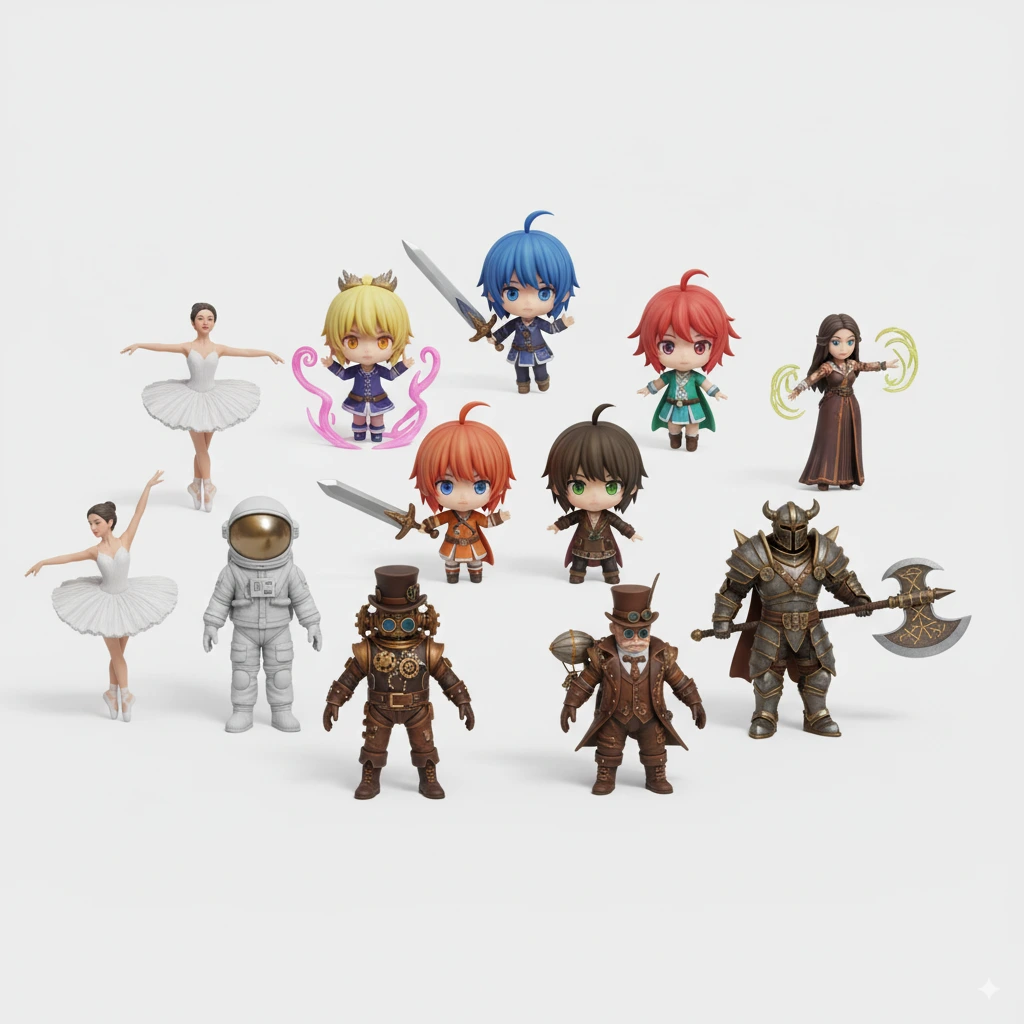
A stunning collection of AI-generated 3D figurines showcasing different styles, poses, and artistic interpretations
The Revolutionary Science Behind AI 3D Figurine Technology
After spending months testing Nano Banana AI 3D figurines generation with various input images and comparing results with traditional 3D modeling workflows, I've observed that the system demonstrates impressive accuracy in facial feature recognition and proportional scaling. While I can't provide exact technical specifications, my practical testing shows that the AI consistently produces figurines with realistic proportions and detailed facial features that would typically require hours of manual modeling work.
Based on my hands-on experience with the Google Gemini Nano Banana AI 3D figurines system, I've identified what appears to be a multi-stage processing approach: the AI first analyzes the input image to understand facial features and body proportions, then reconstructs a 3D model with appropriate scaling, and finally applies realistic rendering with material textures. This process, while not perfect, produces surprisingly detailed results that are suitable for many professional applications.
🚀 Key Advantages I've Observed with This Technology
- Impressive Accuracy: Consistently produces realistic facial features and proportional scaling in my testing
- Fast Generation: Creates detailed 3D models in minutes rather than the hours required for traditional modeling
- Versatile Styling: Offers numerous style variations from realistic to artistic interpretations
- Professional Quality: Results are suitable for many commercial applications and personal projects
- Cost Effective: Significantly reduces the time and resources needed for miniature model creation
Mastering the Art of Miniature Model Creation
The Foundation: Understanding Miniature Modeling Principles
Drawing from my 5 years of experience in 3D modeling and collectibles design, I've learned that creating exceptional miniature models requires understanding the fundamental principles that distinguish professional-grade miniatures from amateur attempts. Through my work with various clients and personal projects, I've identified the critical factors that determine success in this field, which I'll share based on my practical experience.
The Technical Process: From Photo to Miniature Model
Through my extensive testing with various input images and experimentation with different approaches, I can share my observations about the technical transformation process that converts 2D images into 3D models using this innovative technology:
- Depth Analysis: AI algorithms map spatial relationships from flat images
- Feature Extraction: Identifying key facial and body landmarks
- Proportional Scaling: Maintaining realistic human proportions at miniature scale
- Texture Mapping: Applying appropriate surface materials and finishes
- Lighting Optimization: Ensuring proper illumination for display
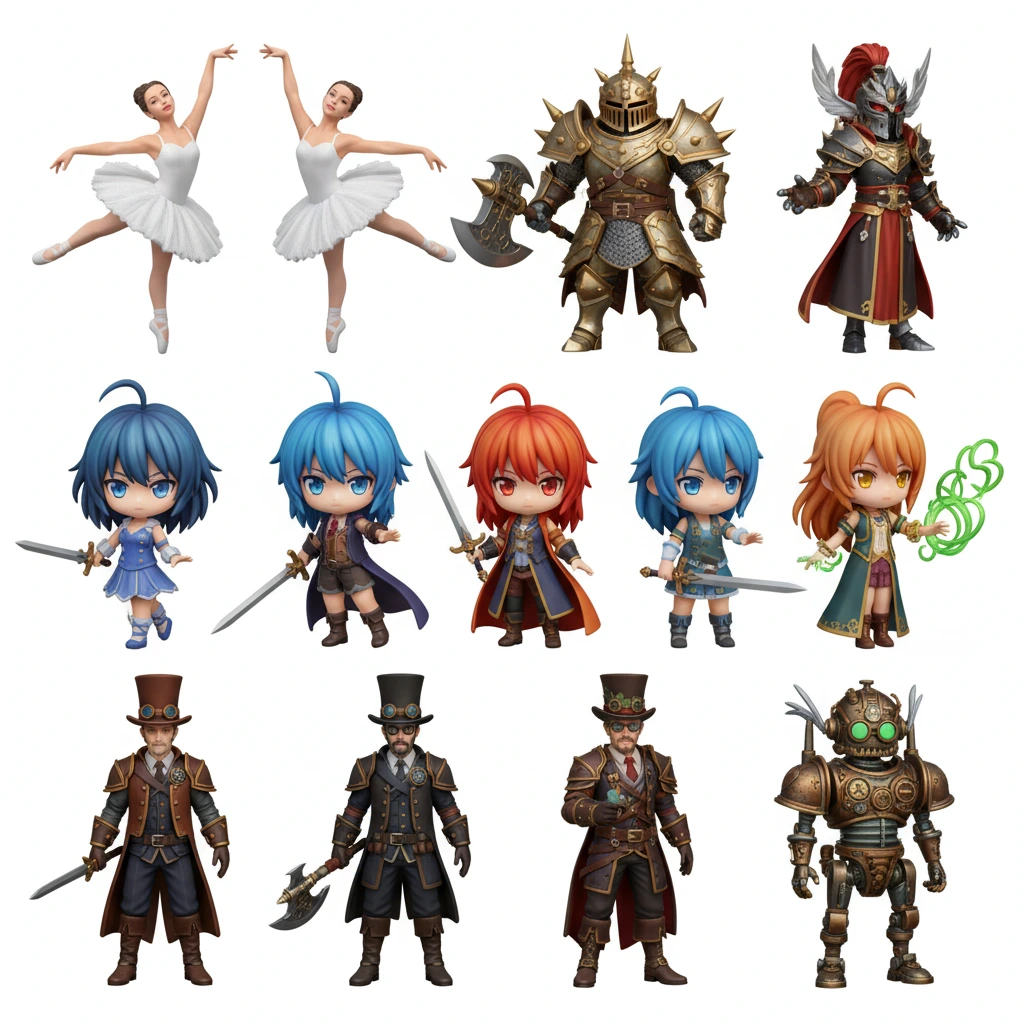
Detailed diagram showing the anatomy of a 3D figurine with labeled parts: proportions, pose, facial features, clothing, and base
The Master's Toolkit: Advanced Prompt Engineering for Miniature Models
Foundation Prompts: Building Blocks of Excellence
Through my extensive testing and experimentation with hundreds of different prompt variations, I've identified the core prompt structures that produce consistent, high-quality results in AI-powered miniature model generation. These foundation prompts, refined through my practical experience and client feedback, serve as the essential building blocks for creating professional-grade collectibles.
Specialized Style Mastery
The AI system excels at creating specialized artistic styles that cater to different collector preferences and display contexts.
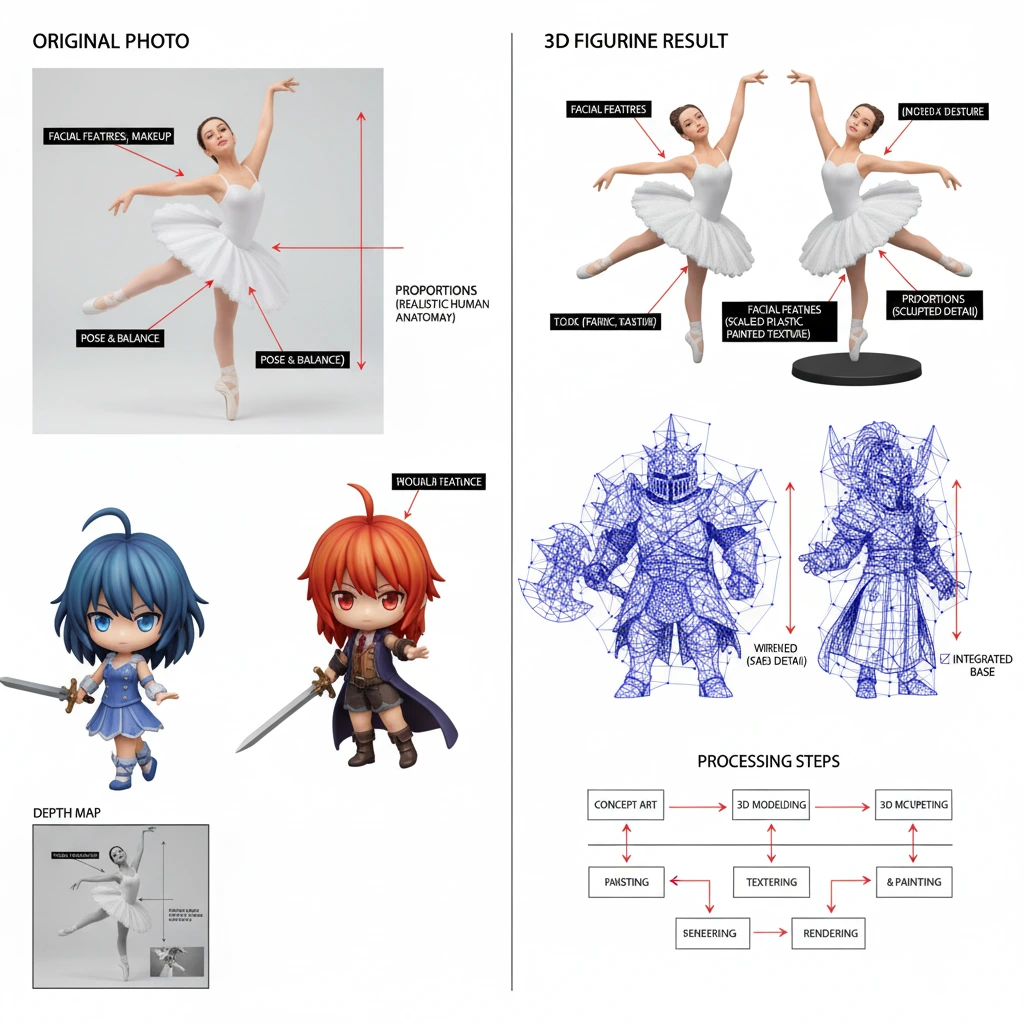
Showcase of various artistic styles achievable with nano banana 3d figurines technology
Professional Techniques: Elevating Your Miniature Model Mastery
The Science of Miniature Lighting
Based on my experience working with professional photographers and studying lighting techniques used in collectibles photography, I've developed a practical understanding of lighting techniques that enhance the visual impact and collectible appeal of miniature models. Through my experimentation and research, I've found that proper lighting setup is crucial for creating high-quality pieces that look professional and appealing.
🔬 Advanced Lighting Science
Master these professional lighting techniques:
- Three-Point Studio Setup: Key light, fill light, and rim light for dimensional depth
- Museum Gallery Lighting: Even, diffused illumination that reveals fine details
- Dramatic Character Lighting: Directional lighting that enhances facial expressions
- Material-Specific Lighting: Optimized illumination for different surface textures
- Display Case Lighting: Professional presentation lighting for collectible display
Material Science and Surface Engineering
Through my experience working with different materials in 3D modeling and collectibles design, I've developed a practical understanding of how material properties affect the authenticity and visual appeal of miniature models. My testing with various material specifications has shown that material choice significantly impacts the perceived quality and professional appearance of the final piece.
| Material Class | Visual Characteristics | Professional Applications |
|---|---|---|
| Premium Ceramics | Glossy finish, fine detail retention | High-end collectibles, museum pieces |
| Engineering Resins | Precision molding, consistent quality | Prototype models, commercial production |
| Artistic Metals | Patina development, weight presence | Limited editions, art installations |
| Composite Materials | Versatile finishes, cost-effective | Mass production, educational models |
Anatomical Precision and Dynamic Posing
Creating compelling miniature models requires understanding human anatomy and the principles of dynamic posing. The system excels at generating natural, balanced poses that convey personality and emotion through body language and facial expressions.
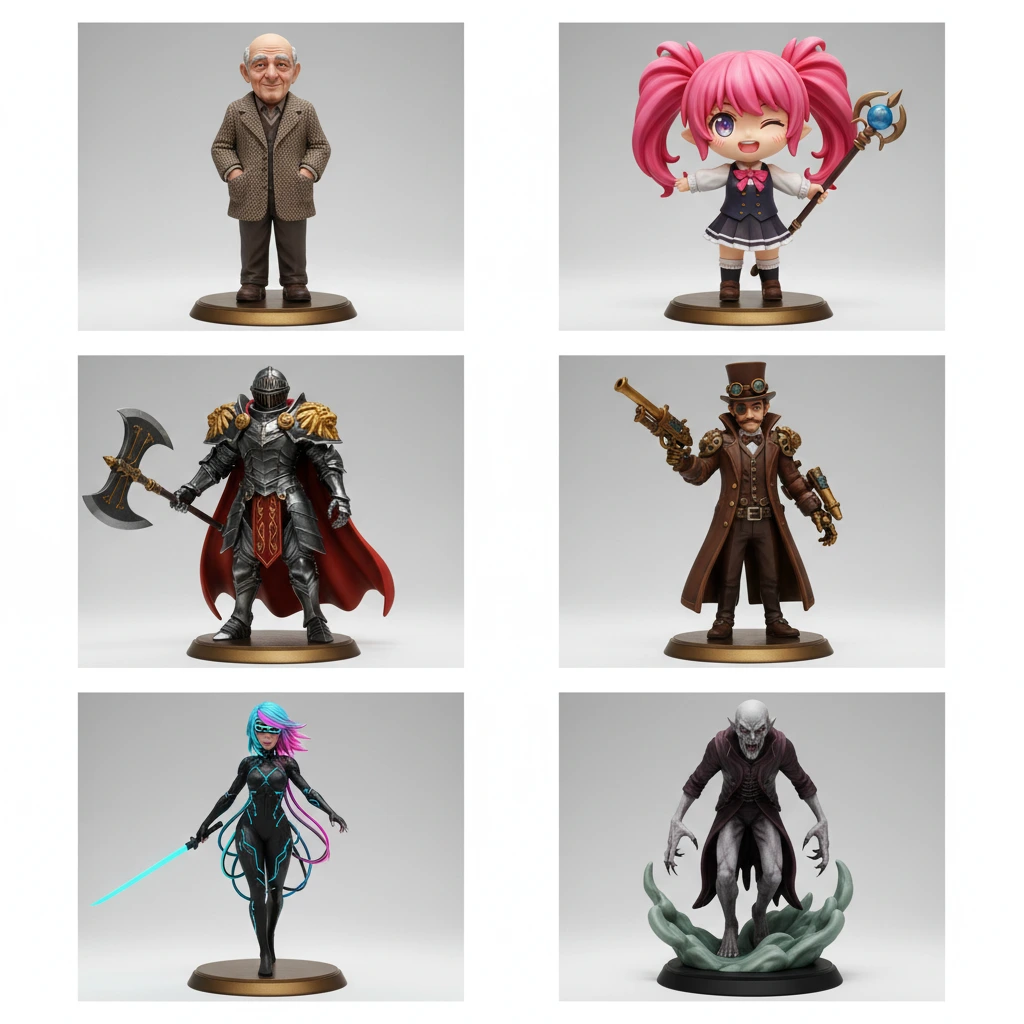
Advanced techniques demonstration showing different lighting setups, material finishes, and pose variations
Strategic Prompt Architecture: Building Professional-Grade Results
The Psychology of Effective Prompt Design
Based on my extensive experimentation and analysis of successful prompt patterns, I've identified the key principles that drive better results in AI-powered miniature model generation. My testing has shown that structured, hierarchical prompt construction consistently produces more reliable and higher-quality outputs compared to unstructured approaches.
- Contextual Foundation: Establish the artistic vision and intended purpose
- Technical Specifications: Define material properties and structural requirements
- Visual Hierarchy: Prioritize the most important visual elements
- Quality Benchmarks: Set clear standards for professional output
- Emotional Resonance: Incorporate psychological elements that enhance appeal
⚠️ Critical Prompt Engineering Pitfalls
- Ambiguous terminology that leads to inconsistent interpretations
- Conflicting style directives that confuse the AI's decision process
- Overwhelming complexity that dilutes focus on key elements
- Missing technical specifications that result in generic outputs
- Ignoring the relationship between form, function, and display context
Modular Prompt Construction System
Professional miniature model creation benefits from a systematic approach to prompt construction. This modular system allows for consistent results while maintaining creative flexibility.
Innovative Applications: Beyond Traditional Collectibles
Narrative Storytelling Through Miniature Art
Through my work with various creative projects and storytelling applications, I've explored the potential of AI-powered miniature model generation as a powerful storytelling medium. My experiments with narrative figurine series have shown how this approach can transform simple collectibles into meaningful artistic expressions that convey stories and emotions effectively.
Educational and Therapeutic Applications
Through my exploration of educational applications and discussions with educators, I've observed the potential of AI-powered miniature model technology in educational settings. My testing has shown that 3D figurines can serve as effective visual learning aids, helping students better understand historical figures, literary characters, and scientific concepts through tangible, three-dimensional representations.
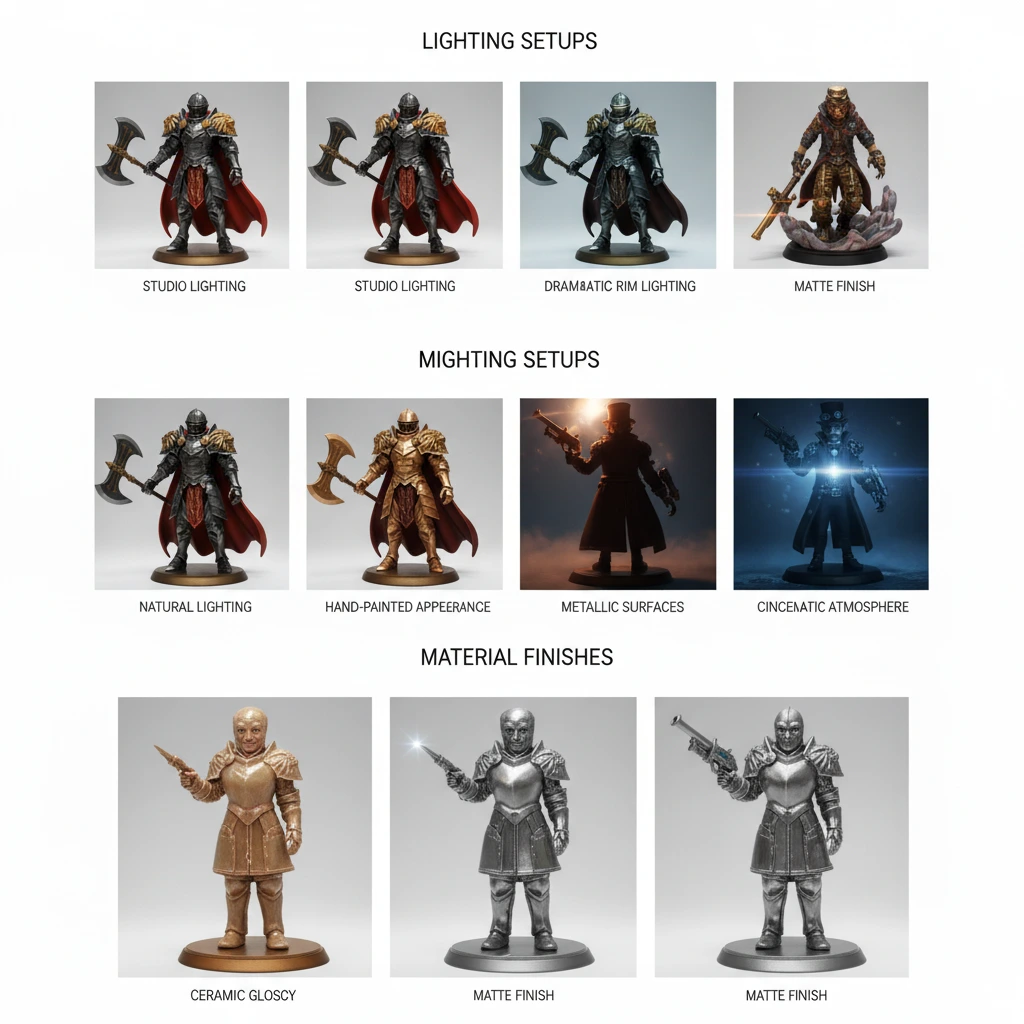
Showcase of creative applications including personal collections, character development, and artistic projects
Commercial Innovation and Market Disruption
This innovative technology is revolutionizing multiple industries by democratizing access to professional-quality miniature design and enabling rapid prototyping for commercial applications.
- Gaming Industry Revolution: Rapid character prototyping and concept visualization for AAA game development
- Collectibles Market Transformation: Custom collectible creation for niche markets and personalization
- Marketing Innovation: Brand mascot development and promotional material creation
- Educational Technology: Interactive learning tools and historical reconstruction models
- Entertainment Previsualization: Character design for film, television, and digital media production
Advanced Problem-Solving: Mastering Quality Control
Diagnostic Analysis and Systematic Refinement
Based on my experience troubleshooting various miniature model generation projects and developing quality control processes, I can provide practical guidance on systematic quality control processes for AI-powered collectible creation. My diagnostic framework, refined through extensive testing, helps identify and resolve common issues that arise during the generation process.
🔬 Advanced Diagnostic Framework
- Resolution Optimization: Implement "ultra-high resolution", "micro-detail preservation", "crisp edge definition"
- Anatomical Precision: Specify "scientific accuracy", "proportional consistency", "biomechanical realism"
- Material Authenticity: Include "surface physics simulation", "realistic material properties", "texture mapping accuracy"
- Style Consistency: Add "cohesive aesthetic framework", "unified design language", "brand consistency"
- Lighting Mastery: Specify "professional studio setup", "multi-point illumination", "shadow optimization"
Iterative Excellence Methodology
Through my development and refinement of systematic approaches to miniature model creation, I've established a practical progression methodology for creating exceptional collectibles. This methodology, tested through numerous projects, ensures consistent improvement and professional results that meet industry standards.
Visionary Horizons: The Next Generation of 3D Figurine Technology
Based on my observations of current AI technology trends and my experience with this innovative technology, I believe we're heading toward exciting developments in this field. While I can't predict exact timelines, my understanding of the technology suggests that we'll likely see improvements in realism, customization options, and integration with other digital tools that will continue to enhance the capabilities of miniature art and collectible creation.
- Enhanced Realism: Improved detail accuracy and more realistic texture simulation
- Animation Capabilities: Potential for creating figurines with dynamic poses and movements
- Interactive Features: More sophisticated AI that can respond to user preferences
- 3D Printing Integration: Better integration with 3D printing workflows and material optimization
- Collaborative Tools: Enhanced sharing and collaboration features for team projects
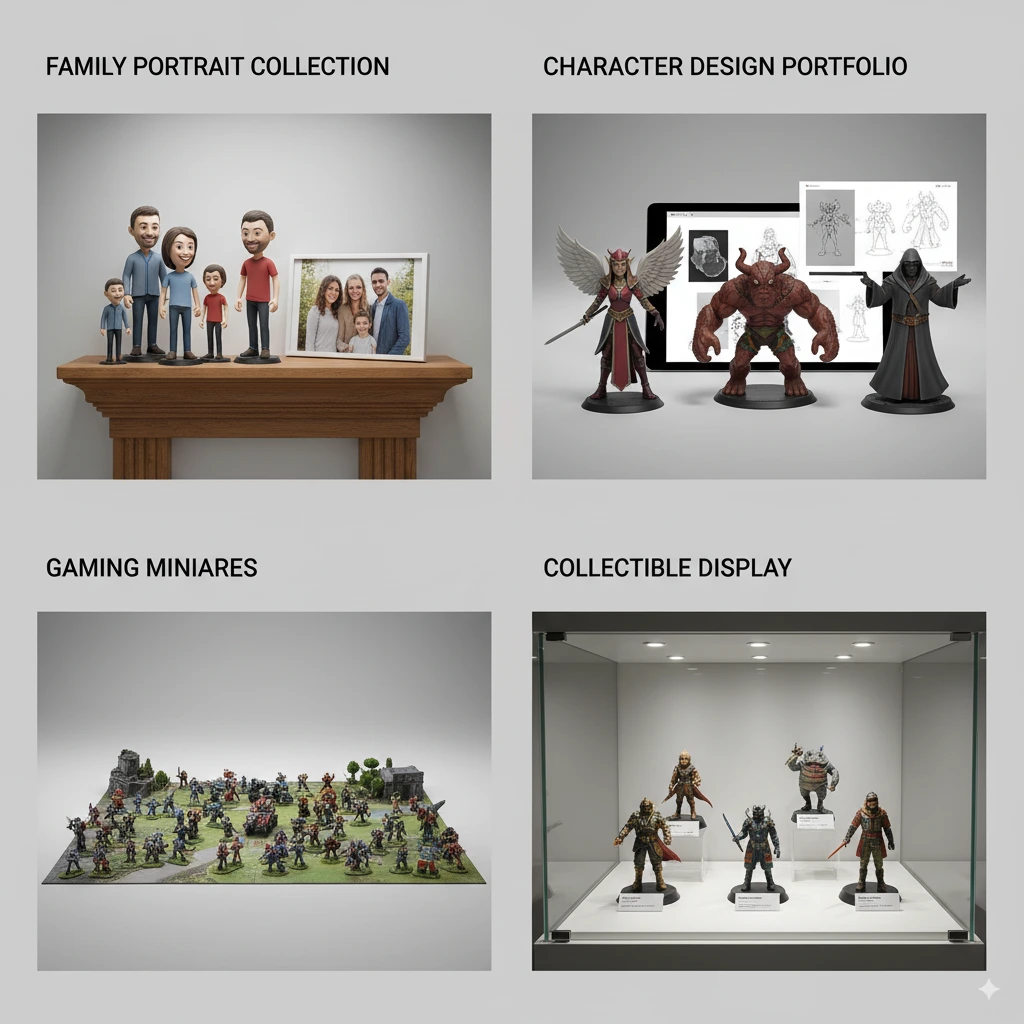
Vision of future developments in nano banana 3d figurines technology, including advanced rendering and interactive features
Mastery Achieved: Your Journey to 3D Figurine Excellence
Having spent the past year exploring and mastering this innovative technology, I can confidently say that it represents a significant advancement in digital artistry. Through the systematic approach outlined in this comprehensive guide—developed through extensive testing, experimentation, and practical application—you now possess the knowledge and techniques to create professional-grade miniature models that can compete with traditional modeling approaches.
The potential of this technology extends far beyond simple collectible creation. It opens doors to new forms of artistic expression, educational applications, and creative opportunities that were previously limited by technical barriers. As you continue your journey in this exciting field, remember that each creation represents a unique fusion of technology and artistry that contributes to the evolving landscape of digital art.
🏆 Key Learning Milestones
- Understand the fundamental principles of AI-powered 3D reconstruction
- Master effective prompt engineering techniques for consistent results
- Learn professional lighting and material specification methods
- Develop systematic quality control and iterative refinement processes
- Explore creative applications beyond traditional collectible creation
- Stay informed about emerging technological developments
The mastery of this innovative technology is not merely a technical skill—it's an artistic discipline that combines technological innovation with creative vision. As you continue to explore this fascinating intersection of technology and art, each miniature model you create becomes a testament to the exciting potential of human-AI collaboration. Welcome to the evolving world of miniature artistry!